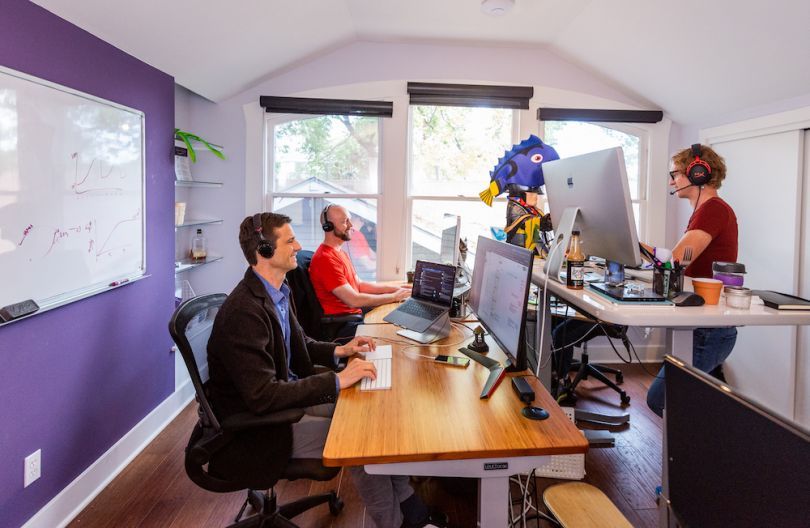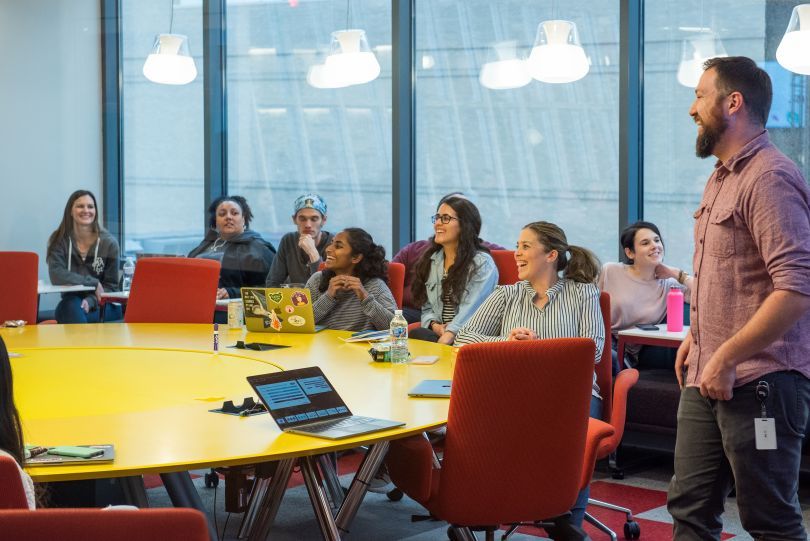Discuss, learn, implement, improve.
Repeat.
This process sums up how many teams approach retrospectives following their two-week sprints, with the ultimate goal being to improve efficiency through the next work cycle. But sometimes, it’s not that easy. Agile teams can face a number of challenges in their retros: working through disagreements and complaints, keeping employees engaged, and ensuring goals aren’t too unrealistic, to name a few.
But perhaps the most significant challenge of sprint retrospectives? Making sure they aren’t all talk.
For the following tech companies, individual ownership is a major part of ensuring action items are acted upon and sprints improve. Teams will often let an individual contributor take charge of ensuring a specific task born from a retro is completed, or ensure other team members are adopting a practice agreed upon during a meeting.
Sometimes, contributors volunteer to be an action item overseer and other times, duties are assigned by role and seniority. But in every case, individuals are empowered to supervise aspects of how upcoming sprints are refined.
Tips for a More Effective Sprint Retrospective
- Provide advanced notice
- Document action items
- Assign ownership
- Avoid any finger-pointing
- Cultivate team trust and acknowledge the human elements
Snapsheet
Lionel Luchez
SOFTWARE ENGINEERING MANAGER

Snapsheet Software Engineering Manager Lionel Luchez said retros for his team at the auto claims management company are a combination of laid-back and structured. The meeting is divided into three phases, with the latter two stages involving open dialogue and team members signing up to own an action item.
How do you structure sprint retrospectives to ensure they’re productive and action-oriented?
As we move through the three phases of the retro, we come up with resolutions, which then become our action items.
Phase one is reviewing closed gaps since the last meeting. We will pull out notes from the previous retrospective and share the progress on those items. Completed items are marked as “done” from the meeting page while outstanding items are copied over into the new meeting page so we don’t lose track of them.
Phase two is where the meeting becomes an open dialogue. Everyone is encouraged to share their thoughts on what they liked or disliked during the sprint. We praise positive contributions and work to correct mistakes and inefficiencies.
The format of phase three is fairly similar to the previous phase, except that we brainstorm on topics from open questions like recent changes, current projects and any issues we encountered. The goal is to get feedback from the team to increase our efficiency while making sure to create an environment that allows each individual to thrive.
"Assignments are determined based on volunteering.”
How does your team decide what the action items should be at the end of a meeting?
For any discussion, we try to dive as deep as possible in order to understand the root cause of each issue. We discuss what should have been the right thing to do in each case and check whether that could be applied to other projects. If that solution cannot be applied on a larger scale, we look for opportunities to standardize our processes and learn from our mistakes. The team then agrees upon the best solution for our current case and lists the resulting action items.
What do you do when there’s a disagreement among the team?
The best retros are the ones with disagreements. We encourage everyone to share their thoughts and debate until we reach a mutual agreement. We also weigh each option’s benefits against its costs to make sure we don’t add unnecessary overhead to the team.
In the end, if there is no clear winning proposal, we either pause the debate or agree to try one of the solutions for some time before appraising it again during a future retro.
How do you decide which team members will handle various action items?
Assignments are determined based on volunteering. We want to make sure everyone has the opportunity to own something — be it a feature, process or something else — that they are excited about. Additionally, failure isn’t counted against you; it’s applauded as long as we learn from it and create something better. Because of that idea, our people are willing to take on action items that are out of their comfort zone. People are more willing to give their best when they feel empowered and when they have chances to show or develop their strengths.
If a task has a decent level of complexity we encourage developers to pair up, preferably with different seniority levels. This kind of collaboration allows younger programmers to benefit from the experience of more senior ones and gives mentoring experiences to the more senior developers.
TopstepTrader
Emily Erdman
MARKETING MANAGER

Retros at financial trading company TopstepTrader are designed around the idea that the right action items should go to the correct contributor. Marketing Manager Emily Erdman said role-specific action items are assigned based on an accountability matrix that ensures responsibilities are given to the person most qualified to see them through.
How do you structure sprint retrospectives to ensure they’re action-oriented?
Our marketing team recently switched over to a “stop, start, continue” model. This is the process of team members reflecting on what they would stop, start or continue doing based on outcomes and learnings of the past two-week sprint. These can be process-oriented takeaways or results-driven outcomes.
Once documented, we assign these tasks to an owner who is most closely related to them. That individual is responsible for keeping individuals or the entire team accountable for these actions. Larger action items discovered in retrospectives are implemented. Smaller actions are noted for the future and acted upon more casually as needed.
"Meetings are designed to understand learnings from the perspective of each team member.”
How does your team decide what the action items should be at the end of a meeting?
These meetings are designed to understand learnings from the perspective of each team member and identify any ways the leadership team can help them improve. So we empower individuals to identify what went well, or not so well, and create their own action items for the future.
What do you do when there’s a disagreement among the team?
There are rarely disagreements between team members, but when there are, we’ll have healthy discussions to understand why something did not go quite as planned. Usually, these discussions end up in a modified action item for the future that accounts for various perspectives.
How do you decide which team members will handle various action items?
One of our core values is “empowered people yield great results.” It was with this belief in mind that we tied a set of accountabilities to each individual role. Regularly auditing the chain of accountabilities ensures that each project is put in the right hands. It then becomes the responsibility of the individual team member to own the project to achieve those key results.
Outrider
Eric Voetberg
PROGRAM MANAGER

Eric Voetberg, a program manager at autonomous yard operations company Outrider, said individuals in his role are tasked with assigning action items to contributors after sprints. Those action items should be made clear to the entire team, and one of those tasks should always include offering praise to top performers.
How do you structure sprint retrospectives to ensure they’re productive and action-oriented?
There are three keys to successful sprint retrospectives. First, provide advance notice of at least one week, which allows team members to prepare their feedback and discuss it with others.
Second, collect feedback in a methodical manner by using a standard template. Then, everyone will know what information to bring and how the retro will be structured and managed. Our meetings start with a review of the sprint objectives, team goals and epics. Then, we celebrate victories and give shout-outs to contributors. Next, we discuss and take detailed notes on what didn’t go well, focusing on root causes, key learnings and ways to avoid failures in future sprints. Our retros wrap up by discussing how to refine the next sprint to make it as good as or better than the last.
Lastly, check egos at the door. Retros go well when team members are humble, honest and forthcoming. What one person might consider insignificant, someone else may not. And the cardinal rule of retros is “no finger-pointing.” Retros are not intended to find or assign blame; they are designed for us to learn and grow, iteratively.
"We make recognition a standard part of our action items.”
How does your team decide what the action items should be at the end of a meeting?
We do not decide or assign action items during the retro. We found that doing so invites people to start resolving things then and there, and that’s not the purpose of the meeting.
After the retro, the facilitator, which is typically the program manager, buckets observations into common themes. The program manager then converts the findings into action items and assigns owners. This list is shared with all attendees, who are then invited to post comments and feedback. Disagreements tend to emerge during this time and we expect team members to work together to resolve the issue. As a result, some action items end up being deferred or considered not applicable. The key is to make space for disagreement, making sure people feel heard and have a resolution. Whether that result is in their favor or not, it’s a decision.
We make recognition a standard part of our action items. It is important to provide recognition in a way that an individual or team will appreciate.
How do you decide which team members will handle various action items?
In order to make sure action items get done, the program manager uses Jira tickets to assign tasks and track status. Typically, we tag action items as “short” or “long-term.” For the shorter-term items, the program manager follows up every few days to check progress. The longer-term items need less frequent check-ins but need to be tracked so they don’t get dropped.
The most important and effective way to ensure action items get done is to make them visible. Create dashboards appropriate to the audience and include status, timing, outcomes and conclusions. Then, share action items frequently in as many channels as possible so everyone knows what the team is out to accomplish.

Billtrust
Neil Sproul
DIRECTOR OF AGILE

Each retrospective is different, and an action item that takes top billing one week might be deemed irrelevant the next. At order-to-cash solution provider Billtrust, Director of Agile Neil Sproul said the team looks at each action item contextually and determines the importance of each one through discussion and voting.
How do you structure sprint retrospectives to ensure they’re productive and action-oriented?
Start with understanding the team and organizational culture, as it will influence how to approach retrospectives. Leading up to the retrospective, confirm the team’s understanding of the event’s purpose and the format that will be used. During the event, contextualize coaching to the team: ask questions, keep people focused, seek clarification and move the conversation toward possible solutions for the things that surface. Don’t focus on detractors by default; unpacking a positive event can hold more insight and open up the conversation faster.
"Foster as much self-organization and team ownership as possible.”
How does your team decide what the action items should be at the end of a meeting?
It depends on the team and what surfaced during the retrospective. Sometimes the action is obvious based on the conversation during the event. If action items are varied in complexity, focus on the highest value items and the expected outcomes. If a team is struggling with what to take on during retrospectives, dot-voting can help the team decide on priority.
How do you decide which team members will handle various action items?
Foster as much self-organization and team ownership as possible. Make action items visible to everyone and have a common understanding of the outcomes desired. Revisit these items often and communicate about them like you would a product feature. Keep a regular cadence of retrospection to surface new improvements and adjust for new learnings.

Square Root
After each sprint, the Square Root team discusses what went well and what didn’t work. Product Manager Ryan Andrews said that, in these retros, it’s the constructive feedback that’s most useful. And that feedback can and does look different for each “herd,” or group of developers.
How do you structure retrospectives to ensure they’re productive and action-oriented?
If all your team’s retrospectives are the same, you’re doing it wrong. At Square Root, we empower each herd to format and carry out retrospectives in a way that works for them. Over time, our herds tune the best activities, cadence and style to facilitate meaningful, actionable conversations that provide real value for each of our team members.
While herds vary their retro styles, all herds have action items in one form or another. Those action items include a list of to-do items or changes that are built as the team discusses communication, process and effectiveness after each sprint. Action items are to be carried out during the next sprint and reviewed at the herd’s following retro.
Additionally, we have a member of our culture team at every retrospective. Their perspective lends a helpful, neutral voice to intra-herd conversation and debates. It also allows the culture team to keep a helpful pulse on the mindset, struggles and makeup of each herd and each radical. Having the “tamers of chaos,” as we call them, involved is the final ingredient in making our retros productive, reflective, inclusive and action-oriented.
How do you decide as a team what the action items should be at the end of a meeting?
Our retrospectives usually feature sections on what went well and what could have gone better. The “could have gone better” conversations are often what produce the most action items. Naturally, we want to take action in areas that could use some improvement.
Retro action items typically focus on improving process, teamwork, communication and relationships. But every herd is empowered to take action items on whatever they see fit.
With an emphasis on experimentation throughout Square Root, teams rarely strongly disagree on action items. The best way to settle any debate is to test the hypothesis in question. If the herd can’t come to a decision on a particular action, they experiment. It’s important that no process change or team adjustments be permanent.
"Insightful retrospectives without action and without follow up would be meaningless.’’
How do you decide which team members will handle various action items? What processes are in place to make sure they get done?
This is ultimately up to each herd. We assign action items to an individual or explicitly state how the whole herd will carry them out. At all meetings, not just retrospectives, it is important to understand who is taking action and why.
Naturally, retrospectives themselves are the perfect place for reviewing previously discussed action items. A herd is free to schedule a separate session for any major action items, but retros usually do the trick. And, if for some reason an action item was not completed, the herd finds themselves in the perfect setting for discussing what went wrong and how it could have gone better.
One of Square Root’s core values is “think big, do bigger.” This value emphasizes the pursuit of ideas that have a big impact. Insightful retrospectives without action and without follow up would be meaningless. Our culture is built for taking action and we always strive to make an impact.

RetailMeNot
Program Manager Michael Denton’s favorite part of any retrospective is its closing. He says the closing presents the perfect opportunity to praise the squad and its individuals for the work that went into the previous sprint. At RetailMeNot, Denton often uses the Retro Dart methodology or a “kudos wall” to facilitate this portion of the retrospective. He also often recommends creating an Agile team working agreement.
How do you structure sprint retrospectives to ensure they’re productive and action-oriented?
“Making Good Teams Great” by Diana Larsen and Esther Derby is a necessary read for anyone interested in improving their scrum ceremonies and, by extension, their team’s productivity and efficacy. At RetailMeNot, we adhere closely to the prescribed process: set the stage, gather the data, generate insights, decide what to do and close.
That said, I have also seen great success when the squad is invited to be vulnerable with the explicit intention of improving individually and as a working team. To elicit that vulnerability, I’ve altered the classic retro phases to draw directly from RetailMeNot’s core values of transparency and teamwork. The updated phases are as follows: assume positive intent; use shared data; make plans actionable, achievable and distributed; and acknowledge the human elements.
We work hard to cultivate empathetic trust. We enter our retros with the belief that no matter what transpired during the sprint, every member of the team leveraged all their applicable skills to contribute the best work they could, given the information available. This mindset ensures all opportunities for improvement derive from a place of mutual respect and admiration.
When documenting data points from the most recent sprint, all squad members must both understand and agree to include the evaluations and assessments, whether they be appreciations or criticisms. In the safe space, each team member should be comfortable asking for additional clarification and investigating the root cause.
"We work hard to cultivate empathetic trust.’’
How do you decide as a team on what the action items should be at the end of a meeting?
Most of the (healthy) disagreement on problem severity happens in the “use shared data” phase of the retrospective process. Similarly, when the team collaborates to “make plans actionable, achievable and distributed,” owners should be identified.
That said, when you can’t easily and quickly identify the solution in the ceremony, it’s necessary to spin up spike or investigation tickets to protect future bandwidth and solve the issue at hand.
How do you decide which team member will handle various action items? What processes are in place to make sure they get done?
Document every retrospective outcome. The living legacy of lessons learned is one of the most valuable artifacts for all successful scrum teams. On the teams I’m fortunate enough to work with, we ticket every action item that arises. We assign as many as possible in the retro itself.
If the owner is not obvious, we ask for a volunteer or leave the ticket unassigned and allow squad members to pull it in as time allows. I also encourage teams to maintain a decision log, ticket all work no matter how small and keep the Agile team working agreement updated. As the team grows, both in size and maturity, the rules of engagement will likely change.





